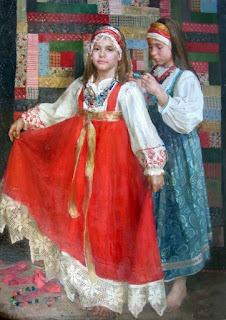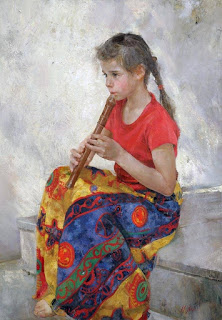97 Natasha Milashevich
Natasha Milashevich is a Russian portrait artist who focuses mainly on children, often in traditional folk dress. She was born in Dushanbe, the capital of Tajikistan somewhere between 1967-8 (two websites give different numbers) and she graduated, first from the Art College of Dushanbe and then later from the Repin Academy in St. Petersberg. She's a member of the Russian Fine Arts Association and has exhibited her work all around the world.
'My Mother's Shawl'
Not much else is publicly available about this artist, as only one interview exists (in Russian) and she's not active on the internet. In that interview, she explains, that she paints her daughter and her friends almost exclusively. Natasha has the girls dress in traditional outfits because she says modern fashions don't feel artistic to her - everyday clothes aren't special enough. She says that she prefers painting children because, "These children still have that innocence, tenderness and children‘s facial features... When they turn 15-16 they start turning into adults and it somehow gets different."
'The Designers'
Although Natasha is not so active on the internet, I was lucky enough to find Vadim Moiseev, director of Academart.com, an online gallery that represents many fine painters in St. Petersburg, Russia. He was kind enough to help me translate back and forth into Russian, so I could conduct this written interview with the artist. My thanks to both Moiseev and Natasha for their kind help and interest in this site. Here's our interview:
1. When did you begin your love for art? When did you begin to take it seriously as a possible career, or area of study?
"My childhood passed in a small industrial city where only a zoological museum was available. These were times before the Internet, so I had the most generalized and superficial knowledge of the world of art. But, I always loved to draw, and at school my skills were always in demand. At first, I did not consider it as a possible career, but rather as a hobby."
'Seesaw'
2. How did your family react to you wanting to be an artist?
"My mother found that my abilities were more than just a hobby before even I understood it. She insisted that I start to study art seriously, and always supported me both morally and financially. I am very grateful to her for this."
3. What was it like studying at university? How were the professors?
"Studying at the Academy was not easy, you need to withstand competition among talented, ambitious students. This makes it difficult to find your style and your idea. I am very grateful to Professor V. V. Sokolov, my teacher, who noticed my interest in the portrait, and supported me in this, and was always kind to me.
'Divine Light'
4. Did you go straight from university to selling paintings as a career, or did you become a teacher somewhere? Were you able to make a living from your art?
"In the wake of the "perestroika" interest in Russian art arose, private art galleries opened, and for the first time our students had the opportunity to sell their educational (and not only) works, this made it possible to buy paint brushes and just live."
5. How did critics respond to your work initially? What do they say now, and does it matter?
"There has been no serious, constructive criticism yet. Of course, it’s nice to get a positive reaction, but it doesn’t have an effect on my creativity."
'Girl with a Lute'
6. Tell me more about your artwork. What is your goal with each piece, and what do you want to say through your work?
"In my work, I do not set ideological super tasks; it’s just fixing the moment, gesture, mood, sometimes special lighting. You need to have the skill to express it plastically and coloristically true. This is a difficult professional task, and this requires school."
7. What do you worry about most compositionally when you create a picture?
"The main theme of my work is a portrait of a child. I am inspired by the image of my daughter and her friends. There are very early portraits where she is no more than 5 years old, and now she is 21 years old. It is interesting for me to observe how she changes, grows up, I reflect this in my works. I often write rural nature, dress my models in simple rustic clothes, this gives me the opportunity to enrich the painting with a special, bright color and light."
8. Are there any lessons that you heard that you still remember when you paint – something wise a teacher told you?
"When the work fails or it’s “going” hard, and this happens often, I recall the advice of my old teacher or turn to my friends, artists, whose opinions I value and inspire me to continue working, for moral support."
9. Russia is famous in art history for its modernism: Kandinsky, Malevich, Gabo, Tatlin, and Rodchenko are all famous for their contributions. Does any of their work influence your own, and if not, was that a problem in school? And, what’s your opinion of modern and contemporary art?
"Yes, these are great artists, but other masters of Russian and Western European art influenced my worldview. Contemporary art meets the new challenges of the modern world. For this it needs the appropriate tools, perhaps traditional methods are not very suitable here, I am interested in observing this process. I admit, most often I don’t understand much, but the world is changing and art should change with it."
'Reading a Book'
10. Who are your favorite artists and why?
"Of the Russians, these are Serov, Malyavin, Vrubel, Kramskoy, Repin (how to be without him). I always study psychology and beautiful painting from them in portraiture. Of course, Italian art, Renaissance artists, the Spanish school of Velazquez, El Greco, the Great Rembrandt, Van Dyck, the Impressionists, everyone loves them. Now, there are interesting young Chinese artists. There are many wonderful masters to learn from."
11. What is your advice for young art students today?
"I would advise students to take the best from everywhere - and the invaluable experience that the classical school gives and what modern art offers while you are young, when you can change and absorb new knowledge. Keep your eyes wide open, look around with curiosity, and take what you need for your ideas."
12. What do you say to people who don’t care about art? Why does it matter to you?
"I admit the idea that art is not interesting to everyone. It is quite possible to live without it, but life with art is still brighter, more interesting, more informative."
'Girl with a Rooster'
'Still Life with Drying'
'Friends'
'Young Graffiti Artist'



















Comments
Post a Comment